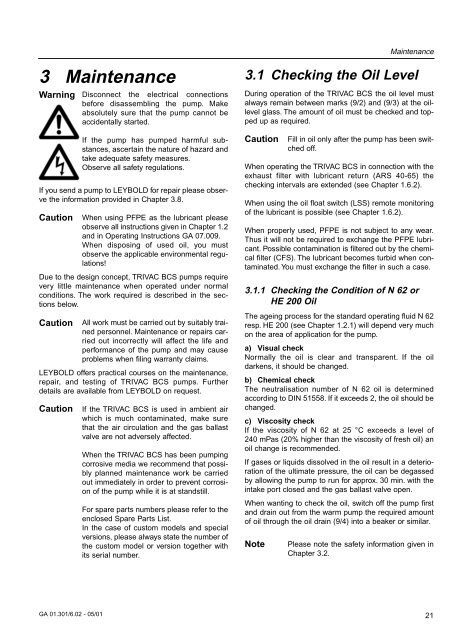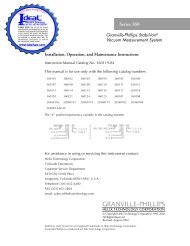Leybold D65BCS, D40BCS, Instruction Manual - Ideal Vacuum ...
Leybold D65BCS, D40BCS, Instruction Manual - Ideal Vacuum ...
Leybold D65BCS, D40BCS, Instruction Manual - Ideal Vacuum ...
Create successful ePaper yourself
Turn your PDF publications into a flip-book with our unique Google optimized e-Paper software.
Maintenance<br />
3 Maintenance<br />
Warning<br />
Disconnect the electrical connections<br />
before disassembling the pump. Make<br />
absolutely sure that the pump cannot be<br />
accidentally started.<br />
If the pump has pumped harmful substances,<br />
ascertain the nature of hazard and<br />
take adequate safety measures.<br />
Observe all safety regulations.<br />
If you send a pump to LEYBOLD for repair please observe<br />
the information provided in Chapter 3.8.<br />
Caution<br />
When using PFPE as the lubricant please<br />
observe all instructions given in Chapter 1.2<br />
and in Operating <strong>Instruction</strong>s GA 07.009.<br />
When disposing of used oil, you must<br />
observe the applicable environmental regulations!<br />
Due to the design concept, TRIVAC BCS pumps require<br />
very little maintenance when operated under normal<br />
conditions. The work required is described in the sections<br />
below.<br />
Caution<br />
All work must be carried out by suitably trained<br />
personnel. Maintenance or repairs carried<br />
out incorrectly will affect the life and<br />
performance of the pump and may cause<br />
problems when filing warranty claims.<br />
LEYBOLD offers practical courses on the maintenance,<br />
repair, and testing of TRIVAC BCS pumps. Further<br />
details are available from LEYBOLD on request.<br />
Caution<br />
If the TRIVAC BCS is used in ambient air<br />
which is much contaminated, make sure<br />
that the air circulation and the gas ballast<br />
valve are not adversely affected.<br />
When the TRIVAC BCS has been pumping<br />
corrosive media we recommend that possibly<br />
planned maintenance work be carried<br />
out immediately in order to prevent corrosion<br />
of the pump while it is at standstill.<br />
For spare parts numbers please refer to the<br />
enclosed Spare Parts List.<br />
In the case of custom models and special<br />
versions, please always state the number of<br />
the custom model or version together with<br />
its serial number.<br />
3.1 Checking the Oil Level<br />
During operation of the TRIVAC BCS the oil level must<br />
always remain between marks (9/2) and (9/3) at the oillevel<br />
glass. The amount of oil must be checked and topped<br />
up as required.<br />
Caution<br />
Fill in oil only after the pump has been switched<br />
off.<br />
When operating the TRIVAC BCS in connection with the<br />
exhaust filter with lubricant return (ARS 40-65) the<br />
checking intervals are extended (see Chapter 1.6.2).<br />
When using the oil float switch (LSS) remote monitoring<br />
of the lubricant is possible (see Chapter 1.6.2).<br />
When properly used, PFPE is not subject to any wear.<br />
Thus it will not be required to exchange the PFPE lubricant.<br />
Possible contamination is filtered out by the chemical<br />
filter (CFS). The lubricant becomes turbid when contaminated.<br />
You must exchange the filter in such a case.<br />
3.1.1 Checking the Condition of N 62 or<br />
HE 200 Oil<br />
The ageing process for the standard operating fluid N 62<br />
resp. HE 200 (see Chapter 1.2.1) will depend very much<br />
on the area of application for the pump.<br />
a) Visual check<br />
Normally the oil is clear and transparent. If the oil<br />
darkens, it should be changed.<br />
b) Chemical check<br />
The neutralisation number of N 62 oil is determined<br />
according to DIN 51558. If it exceeds 2, the oil should be<br />
changed.<br />
c) Viscosity check<br />
If the viscosity of N 62 at 25 °C exceeds a level of<br />
240 mPas (20% higher than the viscosity of fresh oil) an<br />
oil change is recommended.<br />
If gases or liquids dissolved in the oil result in a deterioration<br />
of the ultimate pressure, the oil can be degassed<br />
by allowing the pump to run for approx. 30 min. with the<br />
intake port closed and the gas ballast valve open.<br />
When wanting to check the oil, switch off the pump first<br />
and drain out from the warm pump the required amount<br />
of oil through the oil drain (9/4) into a beaker or similar.<br />
Note<br />
Please note the safety information given in<br />
Chapter 3.2.<br />
GA 01.301/6.02 - 05/01<br />
21

















